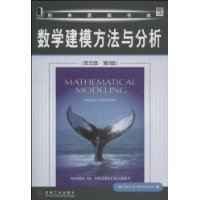数学建模方法与分析(英文版.第3版)
标 签:数理逻辑、数学基础 数学 科学与自然 科普 英文版 英语读物 英语与其他外语
本书提出了一种通用的数学建模方法——五步方法。帮助读者迅速掌握数学建模的真谛。作者以引人入胜的方式描述了数学模型的3个主要领域:最优化、动力系统和随机过程。本书以实用的方法解决各式各样的现实问题,包括空间飞船的对接、传染病的增长率和野生生物的管理等。此外,本书根据需要详细介绍了解决问题所需要的数学知识。
本版新增内容:
增加了关于时间序列分析和扩散模型的新节。
关注国际性问题,如经济预测、人口控制、蓄水池。此外,更新了最优化问题。
Mark M.Meerschaert(米尔斯切特),美国密歇根州立大学概率统计系主任,内华达大学物理系教授。他曾在密歇根大学、莫格兰学院、新西兰达尼丁Otago大学执教,讲授过数学建模、概率、统计学、运筹学、偏微分方程、地下水及地表水水文学与统计物理学课程。他当前的研究方向包括无限方差概率模型的极限定理和参数估计、金融数学中的厚尾模型、用厚尾模型及周期协方差结构建模河水流、异常扩散、连续时间随机流动、分数次导数和分数次偏微分方程、地下水流及运输。
Preface
I OPTIMIZATION MODELS
1 0NE VARIABLE OPTIMIZATION
1.1 The Five-Step Method
1.2 Sensitivity Analysis
1.3 Sensitivity and Robustness
1.4 Exercises
2 MULTIVARIABLE OPTIMIZATION
2.1 Unconstrained Optimization
2.2 Lagrange Multipliers
2.3 Sensitivity Analysis and Shadow Prices
3 COMPUTATIONAL METHODS FOR OPTIMIZATION
3.1 0ne Variable Optimization
3.2 Multivariable Optimization
3.3 Linear Programming
3.4 Discrete Optimization
3.5 Exercises
II DYNAMIC MODEL
4 INTRODUCTION TO DYNAMIC MODELS
4.1 Steady State Analysis
4.2 Dynamical Systems
4.3 Discrete Time Dynamical Systems
4.4 Exercises
5 ANALYSIS OF DYNAMIC MODELS
5.1 Eigenvalue Methods
5.2 Eigenvalue Methods for Discrete System
5.3 Phrase Portrait
5.4 Exercises
6 SIMULATION OF DYNAMIC MODELS
6.1 Introduction to Simulation
6.2 Continuous Time Models
6.3 The Euler Method
6.4 Chaos and Fractals
6.5 Exercises
III PROBABILITY MODELS
7 INTRODUCTION TO PROBABILITY MODELS
7.1 Discrete Probability Models
7.2 Continuous Probability Models
7.3 Introduction to Statistics
7.4 Diffusion
7.5 Exercises
8 STOCHASTIC MODELS
8.1 Markov Chains
8.2 Markov Processes
8.3 Linear Regression
8.4 Time Series
8.5 Exercises
9 SIMULATION OF PROBABILITY MODELS
9.1 Monte Carlo Simulation
9.2 The Markov Property
9.3 Analytic Simulation
9.4 Exercises
Afterword
Index
Problems in optimization are the most common applications of mathematics. Whatever the activity in which we are engaged, we want to maximize the good that we do and minimize the unfortunate consequences or costs. Business managers attempt to control variables in order to maximize profit or to achieve a desired goal for production and delivery at a minimum cost. Managers of renewable resources such as fisheries and forests try to control harvest rates in order to maximize long-term yield. Government agencies set standards to minimize the environmental costs of producing consumer goods. Computer system managers try to maximize throughput and minimize delays. Farmers space their plantings to maximize yield. Physicians regulate medications to minimize harmful side effects. What all of these applications and many more have in common is a particular mathematical structure. One or more variables can be controlled to produce the best outcome in some other variable, subject in most cases to a variety of practical constraints on the control variables. Optimization models are designed to determine the values of the control variables which lead to the optimal outcome, given the constraints of the problem.
We begin our discussion of optimization models at a place where most students will already have some practical experience. One-variable optimization problems, sometimes called maximum-minimum problems, are typically discussed in first semester calculus. A wide variety of practical applications can be handled using just these techniques. The purpose of this chapter, aside from a review of these basic techniques, is to introduce the fundamentals of mathematical modeling in a familiar setting.
装 帧:平装
页 数:335
印 次:1
开 本:16开
正文语种:英语
